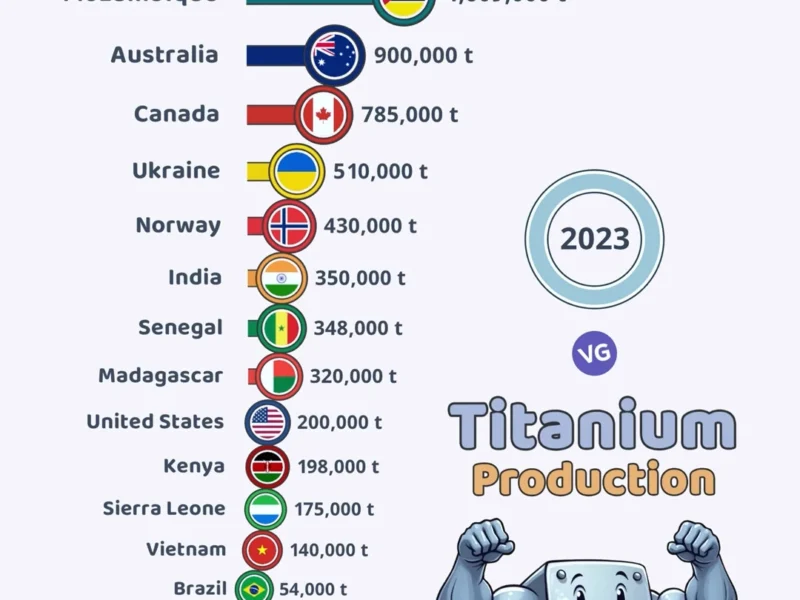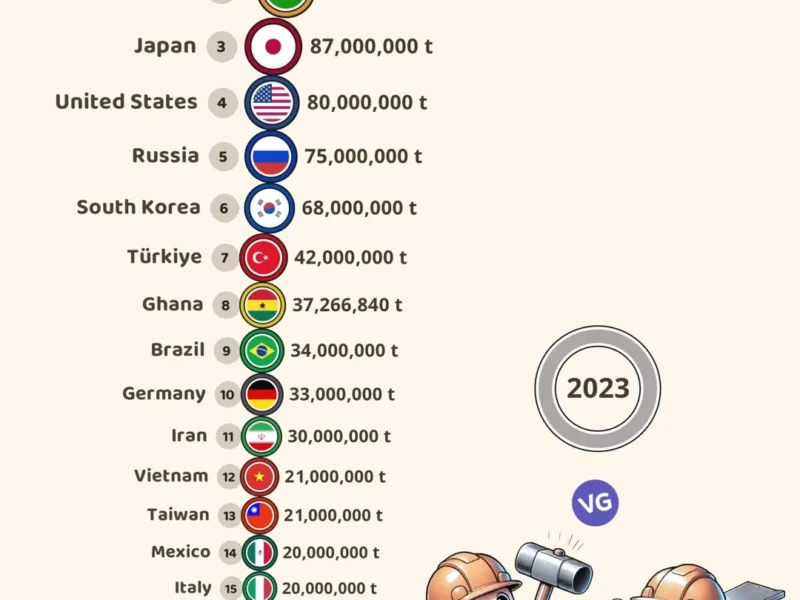In 2020, China made more than 37 million metric tons of primary aluminum. This was over 55% of the world’s total.1 Russia and India were next, making 3.9 million and 3.6 million metric tons. The world’s market for aluminum was worth $179.32 billion in 2022.2 By 2031, it’s expected to grow to $277.5 billion. This metal is light, strong, and used in building, cars, and everyday items.
| Country | Flag | Aluminum Production (tonnes) |
|---|---|---|
| China | 🇨🇳 | 41,000,000 |
| India | 🇮🇳 | 4,100,000 |
| Russia | 🇷🇺 | 3,800,000 |
| Canada | 🇨🇦 | 3,000,000 |
| United Arab Emirates | 🇦🇪 | 2,700,000 |
| Bahrain | 🇧🇭 | 1,600,000 |
| Australia | 🇦🇺 | 1,500,000 |
| Norway | 🇳🇴 | 1,300,000 |
| Brazil | 🇧🇷 | 1,100,000 |
| Malaysia | 🇲🇾 | 980,000 |
| Saudi Arabia | 🇸🇦 | 824,160 |
| United States | 🇺🇸 | 757,500 |
| South Africa | 🇿🇦 | 735,563 |
| Iceland | 🇮🇸 | 730,000 |
| Qatar | 🇶🇦 | 653,147 |
| Mozambique | 🇲🇿 | 576,357 |
| Germany | 🇩🇪 | 510,050 |
| Iran | 🇮🇷 | 469,246 |
| France | 🇫🇷 | 408,040 |
| Argentina | 🇦🇷 | 408,040 |
Key Takeaways:
- China is the world’s biggest maker of primary aluminum, producing 37 million metric tons in 2020.
- Russia and India are the second- and third-largest aluminum producers, respectively.
- The global aluminum market is expected to jump from $179.32 billion in 2022 to $277.5 billion by 2031.
- Aluminum serves versatile roles in construction, car-making, and consumer products.
- Its production and use will likely keep rising because of higher demands from vital sectors.
Introduction to Aluminum Production
Aluminum is a key metal in our world today. It’s known for being light but strong, easy to shape, and a good conductor of electricity. These qualities help it serve many different industries well.2 This metal is everywhere because it comes third in abundance from the Earth’s crust.
Aluminum Properties and Uses
Aluminum is very light, which is good for making cars and airplanes lighter. This cuts down on how much fuel they use and the pollution they make.2 It’s also great for making wires and circuits because it conducts electricity well. And since it can be used again and again, it’s perfect for wrapping food and making drink cans. Because of all these great uses, the metal is heavily used in many areas.
Global Aluminum Production Statistics
Aluminum Production by Country (2023)
Source: USGS
The demand for aluminum has been on the rise globally.2 It’s making big money. In 2022, the global market was worth $179.32 billion. This number is expected to grow to $277.5 billion by 2031. Also, the worldwide use of aluminum reached 65.87 million metric tons in 2022. This is set to rise to 78.4 million metric tons by 2029.2 The best part? About 75% of all the aluminum ever made is still in use today. This shows how well the industry is doing over time.
In 2022, China led the world in making aluminum. It made up 58% of the total aluminum produced worldwide that year.2 The biggest countries making aluminum after China are Russia, India, Canada, the United Arab Emirates, Australia, Bahrain, Norway, the United States, and Iceland. All of these countries help ensure there’s enough aluminum for everyone.
Top Aluminum Producing Countries
When we look at aluminum production by country, we see each has its role. They make a unique contribution to the global aluminum market.1
China, Russia, India, and others are the top aluminum producing countries. They use their resources and skills differently. This helps meet the world’s aluminum needs.1
| Country | Primary Aluminum Production (2020) |
|---|---|
| China | 37 million metric tons1 |
| Russia | 3.9 million metric tons1 |
| India | 3.6 million metric tons1 |
| Canada | 3.11 million metric tons1 |
| United Arab Emirates (UAE) | 2.5 million metric tons1 |
| Australia | 1.6 million tons1 |
| Bahrain | 1.5 million tons1 |
| Norway | 1.3 million tons1 |
| USA | 1.0 million metric tons1 |
| Iceland | Over 800,000 metric tons1 |
For a deeper look into worldwide aluminum production, check HARBOR Aluminum Intelligence. They offer the latest industry info.1
China’s Dominance in Aluminum Production
In 2020, China made 37 million tons of primary aluminum, making it the top producer worldwide.2 It’s a leader in aluminum mainly because of its big manufacturing sector. This sector needs aluminum for cars, buildings, gadgets, and many other things.2 Plus, China ships lots of aluminum goods around the world, thanks to its strong shipping abilities.2 However, its aluminum making relies heavily on coal.2
China’s Aluminum Production Capacity
Last April, China’s aluminum production rose by 8% year on year, hitting 3.2 million tons for that month.3 By these numbers, China is on track to produce about 39.2 million tons in a year.3 This year, its exports reached 1.66 million tons by the end of April.3 While being a top importer of aluminum alloy before, China has recently started exporting more, likely because of a rise in demand for certain types of aluminum products.3 Notably, its need for aluminum scrap grew by 23% year on year from January to April, adding up to 333,600 tons.3 Since the end of 2019, China has been importing more primary aluminum than it exports, with last year’s net imports reaching 1.06 million tons.3 China is starting to lean less on coal for making aluminum, shifting towards cleaner energy sources.3 This change is also affecting aluminum and steel production, pushing for more energy-efficient methods.3 Last month, 146 steel products lost their export tax rebates, hinting at changes coming to the market.3
Major Chinese Aluminum Companies
In China, big players in aluminum include China Hongqiao, Chalco, Yunnan Aluminum, and others.2 These companies are central to China’s aluminum scene. Since 2018, the government has been watching their production closely. It’s part of the effort to care for the environment and stop making too much aluminum.2 Still, China is way ahead in aluminum production globally, even after these control efforts.2
Russia: A Leading Aluminum Powerhouse
Russia comes second in making primary aluminum. In 2020, it produced 3.9 million metric tons, mostly using hydroelectricity.4 The largest aluminum producer after China is RUSAL, located in Moscow.5 UC Rusal, ranking as the third-biggest in the world, made 3.8 million tons in 2021. It has 61,000 employees. Roughly 9% of the world’s primary aluminum comes from them, including alumina.5
RUSAL: Russia’s Aluminum Giant
Russia is a key player in the global aluminum market, being the second-largest producer.4 RUSAL stands out as Russia’s top aluminum producer5. They made 3.8 million tons in 2021, putting them at the third spot worldwide.5
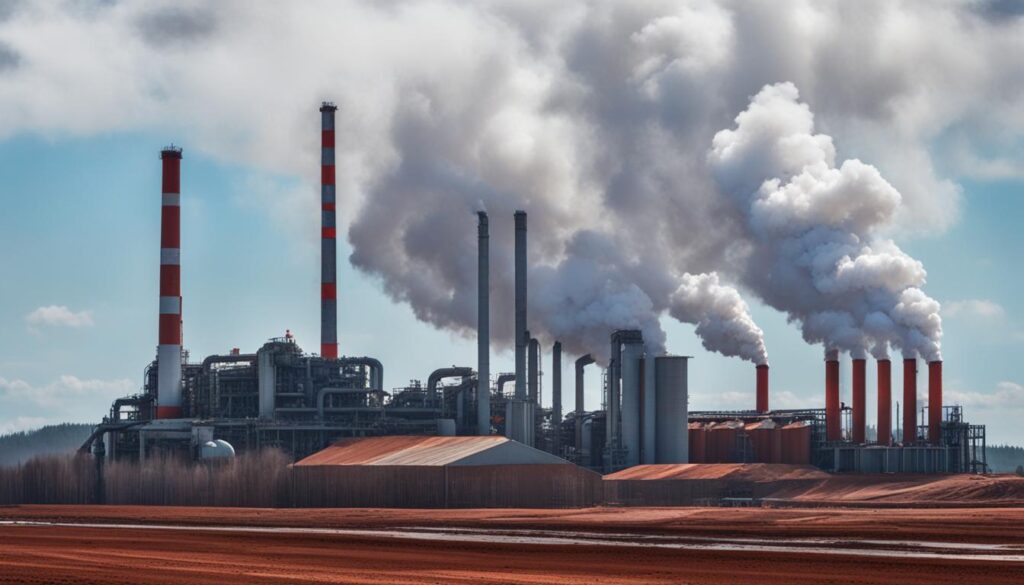
India’s Rising Aluminum Industry
India, part of Asia’s top aluminum producers, made 3.6 million metric tons of aluminum in 2020.6 High demand for aluminum comes from its power, consumer goods, transportation, and construction sectors.7 Most of India’s aluminum production uses coal.7
Vedanta, Hindalco, and Nalco
In India, companies like Vedanta, Hindalco, and Nalco lead in making primary aluminum.8 The top aluminum-producing states are Odisha, Gujarat, Jharkhand, Chhattisgarh, and Maharashtra.8 Odisha is at the forefront, making 49% of all aluminum in India.8 Gujarat follows, contributing 24%.8 Jharkhand comes third, producing 9%.8
The Largest Aluminum Producers in the World
The world’s biggest players in aluminum include China, Russia, and India. Also at the top are Canada, the UAE, and Australia, among others. Together, these countries lead in making the most aluminum.
China is the forerunner, creating a record 37 million tons in 2020. Following behind is Russia, with 3.9 million tons. India’s numbers show its strong presence, hitting 3.6 million tons last year.
Canada focuses on sustainable practices, producing 3.11 million tons in 2020. The UAE made about 2.5 million tons. Australia and Bahrain both hit around 1.6 million tons. Norway’s efficient methods led to 1.3 million tons. The USA added 1.0 million tons. Iceland’s facilities made over 800,000 tons annually.
These leading nations define the world’s market for aluminum. Each one brings its own advantages. This affects the balance of supply and demand for this important metal.
| Country | Primary Aluminum Production in 2020 (million metric tons) |
|---|---|
| China | 37.01 |
| Russia | 3.91 |
| India | 3.61 |
| Canada | 3.111 |
| United Arab Emirates (UAE) | 2.51 |
| Australia | 1.61 |
| Bahrain | 1.51 |
| Norway | 1.31 |
| United States (USA) | 1.01 |
| Iceland | over 0.81 |
Canada’s Sustainable Aluminum Production
Canada is at the forefront of eco-friendly aluminum production. It uses its water power to lessen the impact on the planet. In 2020, it made 3.11 million metric tons, making it the fourth biggest maker in the world.9
Canadian Aluminum Smelters
Most of Canada’s aluminum making happens in Quebec and British Columbia. There are 10 main smelting plants in these areas. They use clean hydropower and this helps Canada have a small carbon footprint in making aluminum.9
Hydroelectric Power and Low Carbon Footprint
Canada’s use of hydropower is unique in the aluminum world. Over 97% of the power used in making aluminum comes from clean sources. This lets Canada produce aluminum with much lower emissions than other big players like the Middle East and China.9
Not only that, the aluminum industry in Canada creates many jobs. It supports around 28,800 people both directly and indirectly in Canada. More than 7,700 of these jobs are in Quebec alone.10 The aluminum Canada sells internationally was worth $7.3 billion in 2020. This is significant for Canada’s overall trade.
In Quebec, the industry is especially important. It makes up 10% of what the province sells to the world. It makes up 8% of the goods that Quebec itself sells. Thanks to its location and the demand from areas like automobiles and ships, Quebec is a key spot for big aluminum projects.10
As the need for eco-friendly materials grows, Canada’s aluminum is becoming more valuable. Its clean energy, advanced tech, and perfect spot on the map are big advantages. This puts Canada in a strong place to lead in making aluminum, a vital metal for many industries.9,11,10
United Arab Emirates: A Global Aluminum Export Hub
The United Arab Emirates (UAE) is a key player in the aluminum world. It made 2.5 million metric tons of primary aluminum in 2020.12 This added up to 1.4% of its GDP in 2018.12 The country ships most of its aluminum to over 70 nations, making it a top exporter globally.
Emirates Global Aluminum
Emirates Global Aluminum (EGA) stands at the heart of the UAE’s aluminum scene. It’s a major player, producing 2.7 million tons in 2022. This accounted for around 4% of the world’s aluminum.12 EGA’s focus on cutting-edge technology and innovation has led it to be a leader in the region.
| Country | Aluminum Production (million tons) | Contribution to Global Aluminum Production (%) |
|---|---|---|
| UAE | 2.7 | 4.0% |
| Bahrain | 1.6 | N/A |
| Saudi Arabia | 1.1 | N/A |
In 2022, the UAE, Bahrain, Saudi Arabia, Oman, and Qatar produced 9.1% of the world’s aluminum. Their total was 6.072 million tons, up 3.11% from the year before.12 This increase shows the region is growing in the global aluminum scene.
The aluminum scene in the UAE is always moving forward. A special project by Sunstone Development and EGA is in the works. It will build a pre-baked anode production base for the aluminum industry.12 This project will boost the country’s position as a top aluminum exporter and show its dedication to grow the industry.
Australia’s Aluminum Production Prowess
In 2020, Australia became a key player in the aluminum industry by making 1.6 million tons of aluminum13. This solidified its place as the fifth-largest producer worldwide13. It also earned the title of sixth-largest aluminum producer13. Over 15,000 Australians work in this bustling sector13, highlighting its vital role in the nation’s economy.
Major Australian Aluminum Smelters
Australia has four major aluminum smelters, located strategically along its coasts. You can find them in Bell Bay (Tasmania), Boyne Island (Queensland), Portland (Victoria), and Tomago (New South Wales)13. Being near the coast helps these smelters get important resources like electricity. It also makes it easier for them to export aluminum to key markets in Asia.
Companies like Rio Tinto and Alcoa make a big impact in Australia. Together, they produce over 1.6 million tonnes of primary aluminum each year13. This shows how important Australia is in the world’s aluminum supply chain.
Australia’s exports of aluminum add a lot to the country’s GDP and give a trade surplus13. But, there are challenges to face, like ups and downs in the price of aluminum13 and trade issues with China13. They also deal with supply chain interruptions13. Still, Australian producers keep their focus on being eco-friendly and coming up with new ideas13. This helps them stay ahead in the global market for aluminum.
Bahrain: A Strategic Aluminum Exporter
In 2020, Bahrain made 1.5 million tons of aluminum, making it a top exporter1. It ships a lot of aluminum to places like the Middle East, Europe, and North America.1 Aluminum Bahrain B.S.C. (Alba), the island’s biggest aluminum maker, is key to this trade.
Aluminum Bahrain B.S.C. (Alba)
Alba is the 2nd biggest maker of aluminum in the world. It put out 1.6 million tons in 2022, helping the economy grow without oil2. Located in Bahrain, this top-notch plant uses its good spot and modern ways to sell aluminum worldwide.
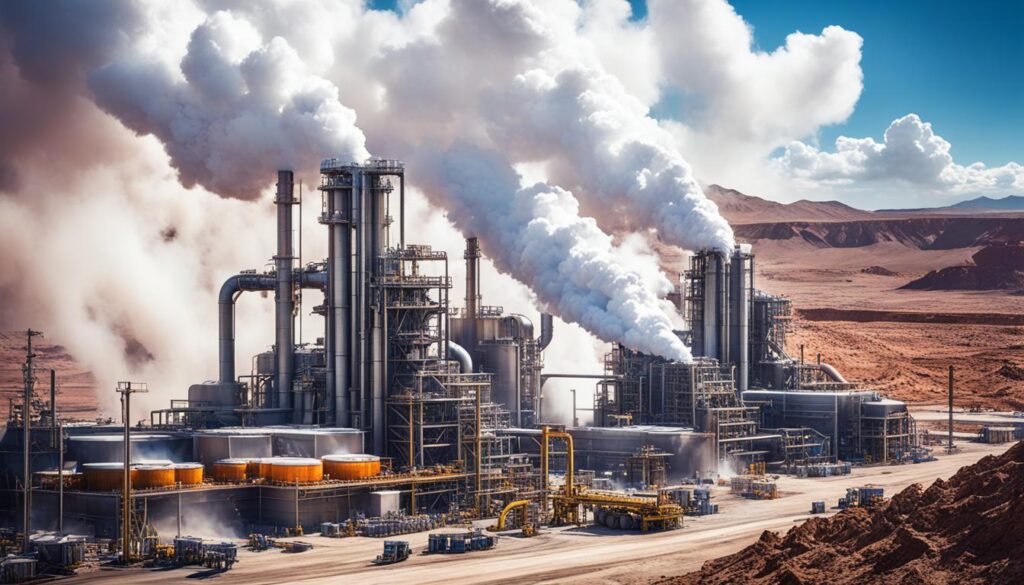
Norway’s Energy-Efficient Aluminum Industry
Norway shines in making aluminum with very little impact on the earth. It creates 1.3 million tons a year, using only clean, renewable energy. This is thanks to Norway’s easy access to clean hydropower.14
Norsk Hydro ASA and Alcoa Norway ANS
Norsk Hydro ASA and Alcoa Norway ANS lead the way in making primary aluminum in Norway.15 Norsk Hydro, a big player in Europe, produces 40% of the continent’s aluminum. The algae in its Hydro Karmøy plant has cut emissions by 55% in three decades.15 Norway’s aluminum is special – it’s carbon footprint is just a quarter of what else in the world.15
Norsk Hydro keeps improving. They want to use even less energy, shooting for just 11.5 kWh per kilo of aluminum, lower than current global and Hydro’s averages.14 At their Karmøy plant, they’ve made bigger electrolytic cells. These can make 50% more metal in a way that uses less energy for each unit of aluminum made. They’ve also switched from using coal to clean hydropower. This change alone stops 1 million tonnes of CO2 from going into our air each year.14 With these upgrades, less CO2 (0.8 kg less for each kilo of aluminum) means 60,000 fewer tonnes of CO2 yearly.14 If all aluminum fac- tories used Hydro’s methods, we could save enough energy to match what all of Norway’s hydropower stations produce in a year.14
The aluminum industry made NOK 35 billion in 2021. It added NOK 3.8 billion to Norway’s tax income.16 Over 6,000 people work for the top six companies. This creates around 20,000 jobs through direct roles, in suppliers, and by boosting local economies.16 Also, 175 places in Norway rely on the aluminum sector for jobs.16
The United States’ Aluminum Production Landscape
In 2020, the USA made 1.0 million metric tons of primary aluminum.17 But, it usually imports more than it makes. Over recent years, the American aluminum industry’s carbon footprint went down 49%. This happened as some smelters stopped operating.17 Today, only six primary aluminum smelters are active in the country.
Alcoa, Century Aluminum, and Magnitude 7 Metals
Alcoa, Century Aluminum, and Magnitude 7 Metals are leading the American aluminum industry.17 They run six smelters across the country. Alcoa Corporation, for example, made 2.2 million metric tons of primary aluminum in 2021. It focuses on making low-carbon alumina, bauxite, and aluminum products.18
The US market is growing, thanks to big projects like a mini-mill in Arkansas and a complex in Texas.18 The CAGR for the North America aluminum market is 4.45% from 2022 to 2030. It’s estimated to be worth $20,848.45 million by 2030.18
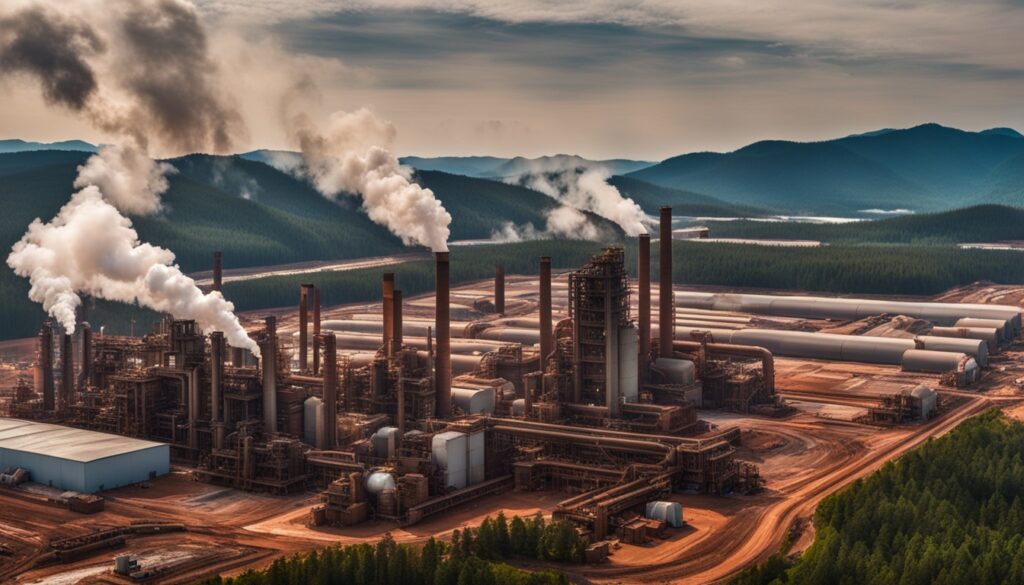
The North America aluminum market has different product types, like primary aluminum and alumina.18 These are used in various industries, including construction, car making, and electronics. Alcoa Corporation and Novelis Inc. are among the top companies in this market.18
Iceland’s Renewable Energy-Powered Aluminum Smelters
Iceland stands out as a top player in making aluminum in a green way. It has three smelters that churn out more than 840,000 tons of aluminum each year.19 The secret is their smart use of sustainable energy, mainly from water and the earth’s heat. This approach shines a global light on what’s possible in industry-wide eco-friendliness.
Thanks to Iceland’s lots of water power, about 73% of the nation’s energy comes from it.19 This huge power boost has been perfect for businesses that use a ton of energy, like making aluminum. In particular, making aluminum is the single biggest energy-eater in Iceland, mostly because of the power-hungry smelting process.19 The location boasts the biggest hydropower plant in Iceland, the Kárahnjúkar, which can pump out 690 MW of power.19 It feeds energy to the region’s biggest dam, Kárahnjúkar, which is 193 meters tall and has enough material to fill 8.5 million cubic meters.19 These feats have powered Iceland up to be one of the big players in global aluminum output.
The aluminum plant in Reyðarfjörður, run by Alcoa, is a star among Iceland’s smelters. It makes 940 tons of the shiny stuff every day, hitting a yearly total of 346,000 tons.19 Overall, Iceland ranks 10th worldwide in making aluminum. Between all three of its smelters, they pump out more than 840,000 tons of aluminum every year for the international market.19 The industry is the biggest consumer of power in Iceland, mostly coming from hydropower.19
The way aluminum is made in Iceland is very different. They use clean, renewable power from under the earth and from the waters.20 This choice has helped them cut way down on pollution when compared to other aluminum makers. In fact, if the rest of the world followed Iceland’s lead, we could save the planet from 550 million tons of extra CO2 each year.21
Creating one ton of aluminum in Iceland’s green smelters is way more energy-efficient than in most smelters.20 Plus, the aluminum that comes out of Iceland’s is much cleaner. This green way of doing things gives Iceland a big edge in the worldwide aluminum market.
The smelters in Iceland that use renewable energy have a big impact. They help Iceland reach its green energy goals.20 Also, the way they make aluminum is much cleaner than in places using non-renewable power. This sets a powerful example for the whole industry.
Emerging Players in the Aluminum Market
Big names like China, Russia, and India lead the way in aluminum. But, new faces are also stepping into the spotlight. Countries like Brazil and Qatar are showing they have a big role to play in the aluminum world.22
Brazil’s Aluminum Potential
In 2018, Brazil produced 0.66 million metric tons of aluminum. This shows Brazil is becoming a strong force in the global aluminum trade.22 The MRN mine, Brazil’s biggest alumina mine, is key. It’s owned by Vale S.A. and it provided a lot of bauxite for making aluminum in 2022.2
Qatar’s Aluminum Industry
In 2019, Qatar made 0.697 million metric tons of aluminum.22 This production amount proves that Qatar is becoming more important in the global aluminum scene.
South Africa’s Aluminum Achievements
South Africa is also making a mark in the aluminum world. In 2019, they hit an impressive 0.699 million metric tons.22 This shows South Africa has a lot of potential in the aluminum industry.
Malaysia’s Bauxite Reserves and Aluminum Output
Malaysia stands out with its 110 million metric tons of bauxite. This led to an output of 0.76 million metric tons of aluminum in 2017.22 Malaysia proves its might in the non-ferrous metals sector.
Saudi Arabia’s Aluminum Ambitions
In 2019, Saudi Arabia produced 0.85 million metric tons of aluminum.22 This amount showcases Saudi Arabia’s ambition in the global aluminum market.
Conclusion
In recent years, the global aluminum market has shown big growth. It is expected to reach $277.5 billion by 2031. This is due to the high demand from many areas like auto, building, and packaging.9 In 2022, the world used about 65.87 million metric tons of aluminum. By 2029, this could rise to 78.4 million metric tons.9
The market’s growth is good for countries that make a lot of aluminum. But, the worry is about using up all the resources. So, there is a big push for aluminum recycling.9 For example, Canada is a big aluminum maker with a green process. The U.S. has also increased its aluminum making by 37.6% recently, key after adding tariffs on aluminum imports.23
New players in the aluminum game, like Brazil, Qatar, and Malaysia, are adding to the market’s growth and variety.24 Looking ahead, there is a chance for more new ideas and efforts to keep up with the growing need for aluminum. This metal is crucial in many different ways.
FAQ
What are the top aluminum producing countries in the world?
The top countries making the most aluminum are China, Russia, India, and others. Canada, UAE, Australia, Bahrain, Norway, USA, and Iceland are also big producers.
How much aluminum does China produce annually?
China makes a lot of aluminum. In 2020, it made 37 million metric tons. This is more than half of the world’s total aluminum production.
What are the largest aluminum companies in Russia?
Russia’s biggest aluminum maker is RUSAL. It’s in Moscow and is the leading producer outside China.
Who are the major aluminum producers in India?
In India, Vedanta, Hindalco, and Nalco are the main companies making aluminum.
How much aluminum does Canada produce annually?
Canada made 3.11 million metric tons of aluminum in 2020. It has 10 smelters, mostly in Quebec and British Columbia.
How much aluminum does the United Arab Emirates produce?
The UAE made about 2.5 million metric tons of aluminum in 2020. Emirates Global Aluminum is a major player in the industry there.
What is the aluminum production capacity in Australia?
In 2020, Australia made 1.6 million tons of aluminum. It has four smelters near the coast for easy access to power and trade routes.
Who is the largest aluminum producer in Bahrain?
In Bahrain, the top producer of primary aluminum is Aluminum Bahrain B.S.C. (Alba).
How does Norway produce aluminum with a low carbon footprint?
Norway leads in eco-friendly aluminum production. It uses clean hydroelectric and geothermal power to smelt the metal.
Which companies are the top aluminum producers in the United States?
Leading aluminum makers in the US are Alcoa, Century Aluminum, and Magnitude 7 Metals. Together, they operate six smelters across the country.
Source Links
- https://www.harboraluminum.com/en/top-aluminum-producing-countries
- https://finance.yahoo.com/news/15-largest-aluminum-producing-countries-085042002.html
- https://www.mining.com/web/home-worlds-largest-aluminum-producer-still-short-of-metal/
- https://financialpost.com/pmn/business-pmn/us-plans-200-tariff-on-russia-aluminum-as-soon-as-this-week
- https://www.alcirclebiz.com/blog-from-ore-to-ingots-meet-the-top-5-aluminium-smelters-in-the-world
- https://www.geeksforgeeks.org/top-10-largest-aluminum-producing-countries/
- https://www.equitymaster.com/research-it/sector-info/aluminium/Aluminium-Sector-Analysis-Report.asp
- https://www.geeksforgeeks.org/largest-aluminum-producing-states-in-india/
- https://www.investquebec.com/international/en/industries/aluminum/the-greenest-aluminum-in-the-world.html
- https://www.canadaaction.ca/aluminum-mining-canada-facts
- https://natural-resources.canada.ca/our-natural-resources/minerals-mining/mining-data-statistics-and-analysis/minerals-metals-facts/aluminum-facts/20510
- https://www.aciep.net/en/2023/08/04/advantages-of-the-middle-east-aluminum-industry-and-its-attractiveness-to-chinese-enterprises/
- https://ozaluminium.au/the-economic-impact-of-australian-aluminium-exports-on-global-markets/
- https://www.hydro.com/en/about-hydro/stories-by-hydro/the-worlds-most-energy-efficient-aluminium-production-technology/
- https://systemschangealliance.org/aluminum-produced-in-norway-has-the-worlds-lowest-carbon-footprint/
- https://www.speira.com/newsroom/press/the-norwegian-aluminium-industry/
- https://www.linkedin.com/pulse/alumina-aluminum-production-processingmarket-size-bgn5f/
- https://inkwoodresearch.com/reports/north-america-aluminum-market/
- https://wright-ingraham.org/hydropower-in-iceland-a-review-of-the-karahnjukar-project/
- https://www.riotinto.com/operations/iceland/isal
- https://nordural.is/en/article/aluminum-is-not-the-same-as-aluminum/
- https://linkedin.com/pulse/aluminum-market-2031-emerging-trends-dynamics-industry-hfate
- https://www.epi.org/publication/aluminum-producing-and-consuming-industries-have-thrived-under-u-s-section-232-import-measures/
- https://sgp.fas.org/crs/misc/R47294.pdf


